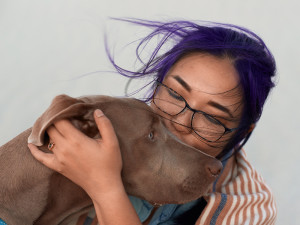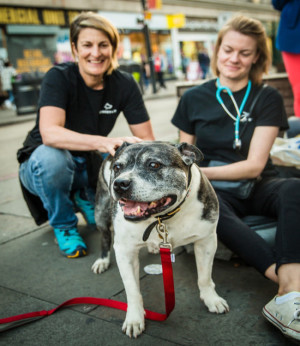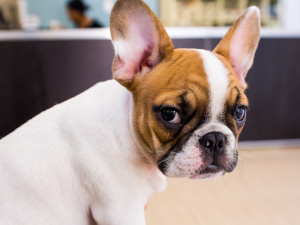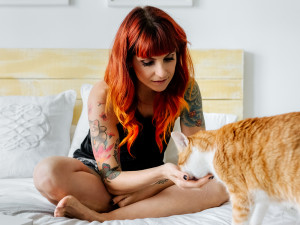What It Takes To Be a Registered Veterinary Nurse
It’s not all cuddling cute puppies and kittens…
share article
In honour of Veterinary Nurse Awareness Month, we asked registered veterinary nurse Zoe Blake to share how she got into the field, what her day to day is like and what she loves most about her work.
“Are you squeamish?” I remember those words vividly as I entered the first day of my school work experience placement. From as young as I can remember, I had a passion for animals: I helped at a local riding school and enjoyed wildlife watching with my dad. So, when I had to find a work experience placement at the age of 14, an animal-related job seemed the perfect fit. That week of my life paved the way for where I am today. I was able to observe and assist the veterinary staff with consultations, operations and visits to horses and farm animals, with the highlight of the week being a walk through a lemur’s cage at a local zoo where my head was used as a stepping stone. I am forever grateful for that time as it showed me that a career with animals was the pathway I needed to take.
My journey as a student veterinary nurse started two weeks after my 16th birthday – placements were hard to find and so I knew I would have to work hard and commit if I was to qualify. The training years were tough and were certainly a steep learning curve. If anyone thinks our job is all about cuddling cute puppies and kittens, it couldn’t be further from the truth. I learnt quickly, and fortunately in January 1996, I passed all my exams first time round.
I moved on from my training practice and eventually found my feet in a practice that was to be my second home for 18 years. Looking back, I actually think I spent far more time at work than I did at home.
What does being a veterinary nurse involve?
As veterinary nurses, we are multi-talented and multi-skilled. No day is ever the same and the saying, ‘You never know what may come through the door next’ is not a myth within our profession. Our job role can vary depending on the type of practice that we choose to work in.
You have first opinion veterinary surgeries, which are like an animal GP; referral practices, where they have leading specialists in their chosen subject, such as orthopaedics; and emergency and out-of-hours clinics that are the equivalent of human A&E. You also have veterinary universities that not only teach students but also double up as specialist veterinary hospitals. You can specialise in the type of patient you like to treat, eg equine, farm animals, cats, dogs and other small furriers, reptiles, zoo animals and wildlife. The experience you gain is vast and the opportunities and doors that open can take you to all corners of the world. It really is an exciting, fast-paced, varied career that is highly rewarding.
There are a few sayings within the profession that notoriously seem to ring true. You never use the ‘Q word’, if you pass on a comment of ‘I hope you have a Quiet one’, the team will be cursed and their day will be manic. The saying ‘things come in threes’ also seems to leave a jinx. If anyone reading this is in the profession, then they know!
What my day to day looks like
In my day-to-day role, I can be doing any of the following:
Radiography: positioning and taking of X-rays.
Anaesthesia: monitoring animals that have been anaesthetised using multi-parameter machines.
Running nurse clinics: these can be about growthopens in a new tab, nutritionopens in a new tab, parasitesopens in a new tab, senior healthcareopens in a new tab, obesityopens in a new tab, joint healthopens in a new tab and more.
Teamwork: we help run the practice, taking bookings, paperwork, answering calls, booking in, sorting appointments, cleaning and keeping the practice stocked.
Preparing pets for surgery: clipping and skin preparation.
Performing minor surgical procedures: stitching up wounds.
Training: learning on the job, completing qualifications but also training juniors and those who have just come into the profession.
Taking blood samples and placing IV cannulas.
Lab technician work: completing internal blood samples and preparing and sending samples to external laboratories.
Nursing in-patients: providing essential care and administering medication.
Counselling: counselling pet parents, offering advice, comfort or aiding grief.
Emergency care: triaging patients and prioritising their treatment.
This is only a small fraction of what I do in my job, it’s ever evolving and with revolutionary new equipment and treatments developing all the time, it’s impossible to get stagnant in this role.
My work across the globe
A few years ago, I was offered a new role as a telemedicine triage nurse for an Australian company. It worked like a 111 service where veterinary practices signed up and then out-of-hours their clients would call us for advice. We would triage and then either give them some support or arrange an appointment. I’ve taken calls about koalas rescued by rangers, kangaroos with broken legs, a duck strangled by a python, spider bites and paralysis from ticks. Wildlife certainly is more dangerous on the other side of the world!
Common themes also include snake bites, which can range in size and toxicity, and are obviously hard to diagnose over the phone. Another striking difference is the size and space – we are so lucky in the UK that vet practices are only ever a few miles away. In Australia, you can live very remotely and can travel for hours without reaching a town, let alone a vet clinic.
The other amazing opportunity I have had was a once-in-a-lifetime trip to Thailand to volunteer for the Wildlife Friends Foundationopens in a new tab veterinary hospital. I was able to work hands-on with elephants, orangutans, gibbons and slow lorises. I even went on a trip to the depths of the jungle to rescue primates from abuse and neglect.
The good, the bad and the cuddly
Being on the front line of veterinary practice means that you do get to witness and assist in many challenging cases. When you take a patient into theatre, it can literally be a matter of life and death. We always rise to the challenge and we treat each patient as if it were our own pet. So what types of cases have been most memorable for me?
Dogs are notoriously bad at eating items they shouldn’t and the following are just some of the objects that have ended up getting stuck inside dogs: Lego, corn on the cob, BBQ skewers, pants, socks, silicone muffin cases, pebbles and bottle caps. The worst case I think we had was a dog that had stolen a roast joint from the kitchen counter and a few hours later when the dog was taken ill, an X-ray showed a five-inch carving knife stuck in their stomach!
Another shocking moment was when a dog parent telephoned through to the surgery to tell us that she was on her way as her dog had cut themselves on a walk and was haemorrhaging. People have different attitudes towards bleedingopens in a new tab and it can often be over-exaggerated. However, it was not the case with this dog: sadly she had run on to a branch that was sticking out across the path, which had punctured her jugular vein. The dog parent’s interpretation of bleeding was definitely spot on.
We were also once called by a branch site to tell us a puppy was on the way that had jumped through a pane of glass. Fortunately, the puppy was a Great Dane, so bigger than most and the pet parent’s quick thinking first aidopens in a new tab helped to save their life.
Ruptured spleens and bladders are always a challenge for many reasons as with it comes a big anaesthetic risk. They certainly leave the theatre with a lot of mess to clean up. Did I mention cleaning? Nurses do a lot of cleaning!
But what about the cute stuff? The caesarean section has to be the one operation that all staff members want to be involved with. I mean why wouldn’t you not want to help bring newborn animals into the world? My favourite will always be a guinea pig, they literally come out like miniature adults – so cute.
I have been lucky enough to witness a vast amount during my three decades and there has certainly been a lot of laughter as well as tears. I have followed dogs through from their first breaths to their last, hand-reared newborn kittens, syringe-fed orphaned hedgehogs and have nursed critically ill puppies with life threatening parvovirusopens in a new tab. There is nothing more rewarding than leaving a tear-soaked family wondering if it’s the last time they are going to see their furry best friend to reuniting them a few days later when you have achieved the impossible.
So, with May being veterinary nurse awareness monthopens in a new tab, I certainly am proud of what I have achieved in and out of the surgery. I wouldn’t hesitate recommending this career for anyone who has a passion for animals. It’s diverse, fast-paced, challenging, tiring but equally rewarding. Just remember to pack your tissues and make sure you enjoy eating cake (something we seem to do a lot).

Zoe Blake RVN, ISFMCertFN / AdvCertFB, MISAP
Zoe is a registered veterinary nurse and has been in the profession for over 30 years. She enjoys educating pet owners on all aspects of their care and regularly writes to support her work. When she is not chatting animals, she can be found running around the tennis court or exploring the countryside with her rescue dog, Dylan.
Related articles
![Two vets sit on the pavement in the background with an old Staffie dog in the foreground.]() opens in a new tab
opens in a new tabHow StreetVet Supports People and Their Pets Experiencing Homelessness
Meet the charity that helps protect the animal-human bond
![French bulldog puppy looking scared at vet]() opens in a new tab
opens in a new tab10 Things to Ask At Your First Vet Visit
There are no stupid questions when it comes to your dog’s health
![Smiling veterinarian examining medical documents of a Bulldog standing on her examination table]() opens in a new tab
opens in a new tab10 Tips to Give Your Dog a Blissful Vet Visit
Reduce the stress of vet visits – for you and your pup
![Young modern woman with tattoos and orange hair sitting cross-legged on her bed with her cat]() opens in a new tab
opens in a new tabDoes My Cat Really Need to See a Vet?
Cats can be hard to read. Especially when they’re sick. Or… not sick? We asked a veterinarian how to tell
![vet smiling at dog]() opens in a new tab
opens in a new tabA Vet Explains How To Keep Your Pet’s Medical Bills Low This Winter
As a vet working in emergency practice, I often see cases where these bills could be reduced or avoided altogether







